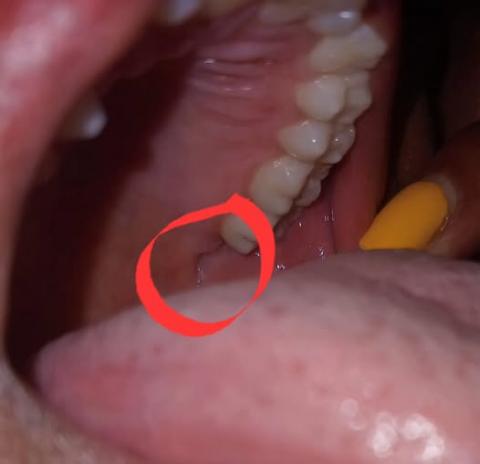Pimple on Gum After Tooth Extraction: What It Means and When to Worry
Professional Analysis: Post-Extraction Bump 3 Months After Wisdom Tooth Removal
Observation
In the circled area of the extraction site:
The gum appears healed overall.
There’s a small, raised, round bump (like a pimple or blister) where the wisdom tooth socket used to be.
No visible bleeding or large open wound.
Possible Causes
1. Minor Gum Abscess or Sinus Tract
This is one of the most common causes.
Sometimes, after extraction, a small pocket or residual infection forms deep in the bone.
If bacteria remain trapped (for example, near the root area or bone fragment), the body may form a tiny drainage point on the gum — appearing like a pimple that may come and go or release a bit of fluid.
-
Typical signs: No severe pain, but mild tenderness or a salty taste if it drains.
2. Bone Spur or Sequestrum (Small Bone Fragment)
After extraction, sometimes a small piece of bone (sequestrum) slowly works its way out as the gum heals.
This can irritate the gum tissue, forming a little bump or ulcer.
-
Typical signs: A hard or sharp feel when you touch it; might feel like a tiny chip under the gum.
3. Soft Tissue Cyst or Granulation Tissue
In a few cases, the extraction site heals with excess granulation tissue — over time, it can form a fibrous bump or a small cystic sac if there’s a trapped epithelial cell.
-
Typical signs: Soft, movable bump that doesn’t hurt much; color similar to gum tissue.
4. Recurrent Infection of a Residual Root or Debris
If even a small portion of the root tip, tooth fragment, or stitch material was left, your body might be trying to expel it now.
-
Typical signs: Mild swelling, discomfort on biting, or drainage when pressed.
Is This Serious?
Usually, it’s not dangerous, but it should be checked.
Even though it looks mild, a small abscess or sinus tract indicates something under the gum isn’t fully resolved — and if left untreated, it can slowly enlarge or reinfect the bone.
Recommended Actions (Solution Plan)
Step 1: Clinical Evaluation
-
Visit a dentist or oral surgeon for a quick visual and periapical X-ray.
-
They will check for:
-
Residual infection or root tip
-
Bone fragments
-
Sinus tract formation
-
Step 2: Gentle Cleaning and Irrigation
If infection or debris is found, the dentist will:
-
Gently open or flush the area with saline or antiseptic solution
-
Remove any trapped bone fragment or tissue plug
Step 3: Short Course of Antibiotics (If Needed)
If there’s infection or pus drainage, your dentist may prescribe:
-
Amoxicillin-clavulanate or Clindamycin (if allergic to penicillin), typically for 5–7 days
Step 4: Warm Saltwater or Chlorhexidine Rinse
At home, rinse twice daily with:
-
Warm saltwater (1 tsp salt in 1 cup warm water)
-
Or 0.12% Chlorhexidine mouthwash (avoid eating/drinking for 30 min afterward)
Step 5: Follow-up in 1–2 Weeks
-
The dentist will confirm if the bump has resolved.
-
If persistent, a small biopsy or further imaging (CBCT) can rule out a cyst or deep infection.
Preventive Tip
Even if the area seems minor, don’t try to squeeze or puncture it — that can push bacteria deeper.
Keep the area clean, avoid trauma (hard foods), and let your dentist handle the drainage if needed.
Summary
-
The “pimple-like” bump after extraction is most likely a small gum abscess or healing sinus tract.
-
It’s a minor but important sign to get checked by your dentist.
-
With proper cleaning and possibly a short course of antibiotics, it usually resolves quickly.





